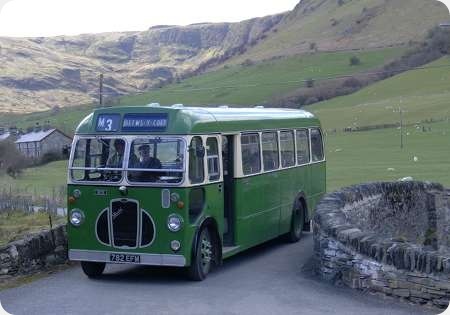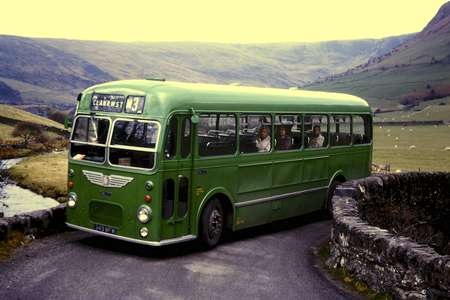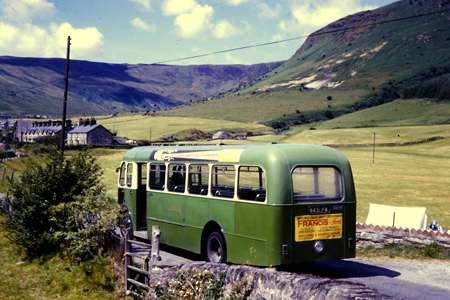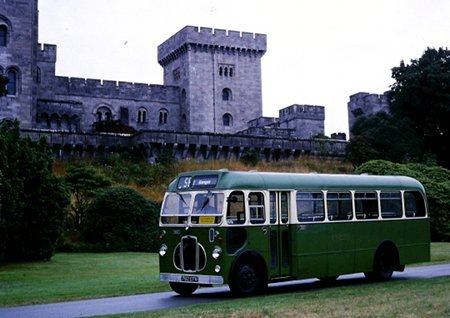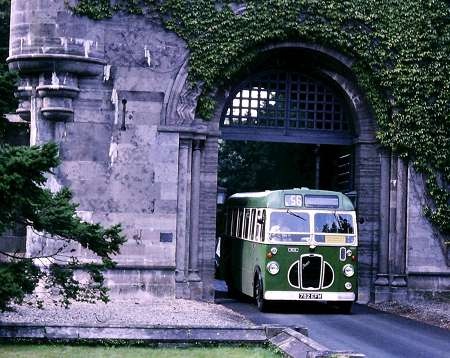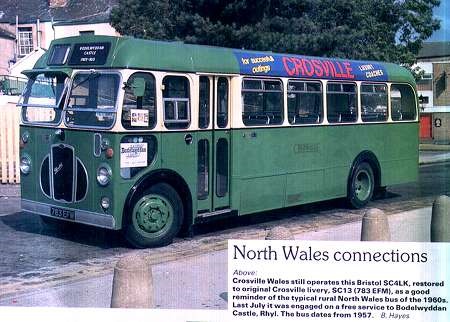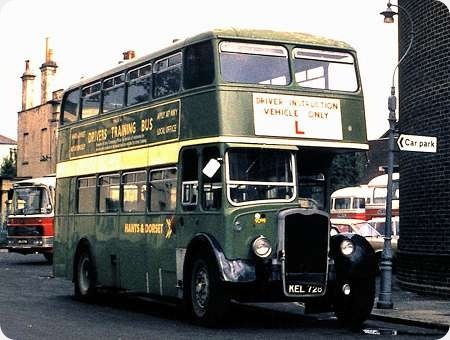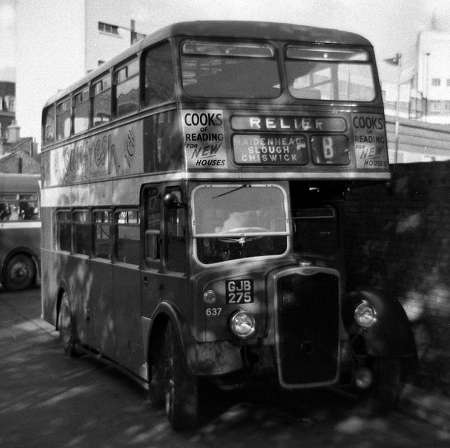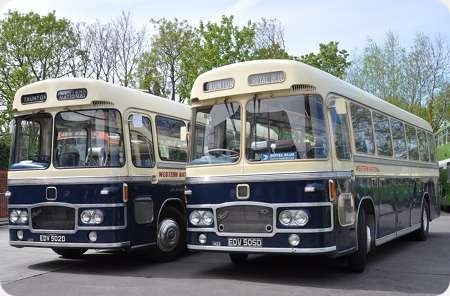Crosville – Bristol SC – 782 EFM – SC 12
Crosville Motor Services
1957
Bristol SC4LK
ECW B35F
Crosville was one of the main users of the Bristol SC4LK model, with a total of seventy nine examples, of which fifty five were buses and twenty four were coaches, although the latter were soon downgraded to bus status, without being greatly modified. The first batch were new in 1957, numbered SC1 – 16. but in May 1958 they were renumbered SSG 601 – 616. These vehicles were a familiar sight in most of the Company’s Welsh areas, with their small size making them ideal for running along single-track roads. The Gardner 4LK engine resulted in extremely good fuel consumption (over 20mpg) but limited their speed capability. It was often said that they could climb any gradient, but might take all day to do it!
After withdrawal, SSG 612 was used as a maintenance vehicle for the Runcorn Busway, numbered G612. This enabled it to be bought for preservation and restored to its present superb condition. In April this year, the bus, now carrying its original number SC12, was used for a Crosville Enthusiasts Club outing, revisiting some of the routes which used to be operated by this type. it is seen here at Cwm Swch, having just left Cwm Penmachno, the terminus of Crosville’s route from Llanrwst and Betws-y-Coed. This route is nowadays covered by Llew Jones using Optare Solos – a very poor comparison, although it can perhaps be said that the Solo is a modern day equivalent of the SC!
Photograph and Copy contributed by Don McKeown
16/06/16 – 05:52
Arguably, United must have covered the largest geographical area of any Tilling/BTH group company. I don’t know how many vehicles or depots they had, but numbers at each varied from a handful up to a hundred or more. Many operating areas were similar to those of Crosville, but so far as I am aware, United avoided this particular Bristol/ECW offering like the plague
Ronnie Hoye
16/06/16 – 05:52
Nice view, Don, and not just of the bus! Thanks for posting. Here’s a silly question. It’s clearly a full-fronted vehicle which, in most circumstances, would be recorded as ‘FB’ or ‘FC’, so what was it about the SC series that it was felt B or C alone would suffice?
Pete Davies
16/06/16 – 09:41
By way of comparison, I attach an image from a slide of a standard Bristol MW6G bus SMG 373 taken in the early 1970s on service M3 seen returning to Llanrwst – the driver kindly stopped to permit the photo. At the time the SC and MW types were the regular vehicles on the Llanrwst country routes – those were the days.
Keith Newton
16/06/16 – 10:18
The Bristol SC series was designed and always built as a full front vehicles, never as a half-cab. Therefore the decision makers in the PSVC decided that a plain B or C would suffice. The same rule is applied to Bedford SB, Ford 570E and Commer Avenger coaches. I don’t think I have ever travelled on an SC4LK. From the descriptions here and elsewhere, I’m glad I didn’t do so in their hey-day, but curiosity today might just make me try one at a running day!
Michael Hampton
16/06/16 – 12:37
The attached photo was taken from the bridge looking to the terminus at Cwm Penmachno again in the early 1970s and again the driver had kindly stopped. The running times in those days were very generous even for an SC and the Llanrwst drivers were always very friendly towards a young English enthusiast riding into deepest Wales. With grateful thanks to them.
Keith Newton
16/06/16 – 13:22
Thank you Michael.
Pete Davies
17/06/16 – 15:55
In answer to Ronnie’s query my 1967 Crosville Company Fleet List shows there were 1,173 buses + coaches plus 15 service vehicles in the fleet in an ’empire’ stretching from Newcastle-under-Lyme in the east to Aberaeron in the west. That’s throughout England and Wales of course, and 32 Depots plus 3 sub-depots (outstations) ranging from 1 vehicle at Barmouth to 123 vehicles at Wrexham.
Referring to the Bristol SC4LK I agree with all the comments about them, but nevertheless have a soft spot for them, I suppose because they were such a nostalgic part of my summer holiday bus riding in North Wales. The cacophony of the engine noise and the vibration on a long uphill gradient such as ascending the Crimea Pass could likely induce a nosebleed in those susceptible, and combined with the competing din of twenty-odd housewives chattering in Welsh on a returning market day service from Llanrwst to Blaenau Ffestiniog would ensure your ears not just popping but actually ringing for ages after you hurriedly made your exit in Duffwys Square! That was the R34 service from Blaenau Ffestiniog to Llanrwst taking all of 1 hour and 10 minutes. I think the reason why the smaller vehicle was chosen in preference to an MW was that between Betws-y-Coed and Llanrwst, unlike any of the other services linking those towns, it operated down the western side of the Conway Valley, i.e. via Cwmlanerch and then had a tight turn onto the river bridge at Llanrwst.
It operated two return journeys from Blaenau Ffestiniog throughout the year, although I should think that it was occasionally suspended in winter when snow afflicted the Crimea Pass!
Those two journeys were denoted in the timetable by L, indicating Llanrwst Market and Fair Day.
It then helpfully mentioned that Lanrwst M.D. was Tuesda , but would not operate in the week of Fair Day (Wednesday following the first Tuesday of the month) when it would operate on the Wednesday instead! Such operational trivia used to be common in rural area timetables all over Britain. In North Wales other Market Day/Fair Day footnotes were necessary for Denbigh and Ruthin. To digress a little I used to live near Lancaster and the Ribble timetable for service 79/80 between Lancaster and Knott End on Sea had amongst the various codes the footnote: ‘On the occasions when the tide renders the direct route between Conder Green and Glasson Dock impassable, the route will be diverted via Upper Thurnham’. Today, a ‘dyke’ has been constructed making such interesting diversions away from the cold muddy River Lune estuary well and truly a thing of the past.
Back to the SC’s.
The subject of Dan’s article SSG 612 was perhaps in Dan’s photo of the late 50’s, allocated to Llanrwst. In 1967 it had migrated to Pwllheli, or Porthmadoc outstation, maybe for the Borth-y-Gest /Morfa Bychan service.
The other allocations, including the downgraded 33 seater ‘coach-seated versions (CSG’s) were:
AN Aberaeron 1
AYH Aberystwyth 4
AMH Amlwch 2
BR Bangor 8
BF Blaenau Ffestiniog 2
CFN Caernarfon 9
CR Chester 3
CWN Corwen 3
DH Denbigh 6
DU Dolgellau 2
HD Holyhead 2
JT Johnstown 5
LL/T Llandudno Town 4
LJN Llandudno Junction 5
LT Llanrwst 6
MYH Machynlleth 3
OY Oswestry 2
PI Pwllheli 5
Incl. Porthmadog O/S)
RL 5
WXM 2 (Total = 79)
SSG 612 and sister SSG 613 were eventually preserved,even appearing on Crosville Wales heritage services in the mid 90’s. Perhaps someone else will be able to continue that story.
David J. Smith
25/06/16 – 06:32
Thanks David for the garage allocation. My sister lived in Wales for much of the 1960s, in various locations between Barmouth and Harlech and I had a vague memory of seeing a Bristol SC in Barmouth. The allocation list shows a couple at Dolgellau, so no doubt I will have seen them –and ridden on them – on the S34 service between the two towns.
I reckon all enthusiasts will have some regret about disposing of items many years ago which they wish they had kept. Mine would have to be a complete set of Crosville timetables, five volumes I think, from the late 1960s. I would give my right arm to still have them. There must be dozens and dozens of small Welsh villages which no longer have a bus service and it would be fascinating to read them.
Dave Towers
27/06/16 – 06:40
To conclude the small gallery of Crosville Bristol SC buses I am attaching two more photos of SC12. This was used in the 1990s along with SC13 on various vintage services by Crosville. It is seen on the service based at Bangor which linked the town with both Beaumaris on Anglesey and Penrhyn Castle which is owned/managed by the National Trust. As far as I am aware this was the first time a bus service had entered the grounds of the castle.
Keith Newton
02/10/16 – 06:00
SC12 was renovated at Crosville Motor Services Sealand road central repairs in Chester in the early 80s. I was an apprentice who along with others worked on the bus.
As it was being completed Enigmas Film Productions hired the bus for a Chanel Four film directed by David Putnam. The film was called “Experience Preferred but not Essential” (look it up on you tube and you will see the film).
My dad Eric Manley was a driving instructor at the time at Crosville and was the driver in the film.
The film was based in Phylleli North Wales in the 60s however it was filmed in Douglass Isle of Mann as in the 80s Phylleli was not as it was in the 60s.
Kevin Manley
24/01/22 – 06:34
I restored this bus in the 70s and sold it back to Crossville Wales.
It was a strip back and total restoration.
I have pics of every stage of this restoration which answers many of the queries I read in the feedback so far.
I am happy to send these to anyone who can use them.
I heard that SC 12 had been badly damaged in a front end collision?
So she may have been scrapped?
I last saw SC13 at The Llandudno rally in about 2007, now privately owned.
Pat Honey
Quick links to the - Comments Page - Contact Page - Home Page
